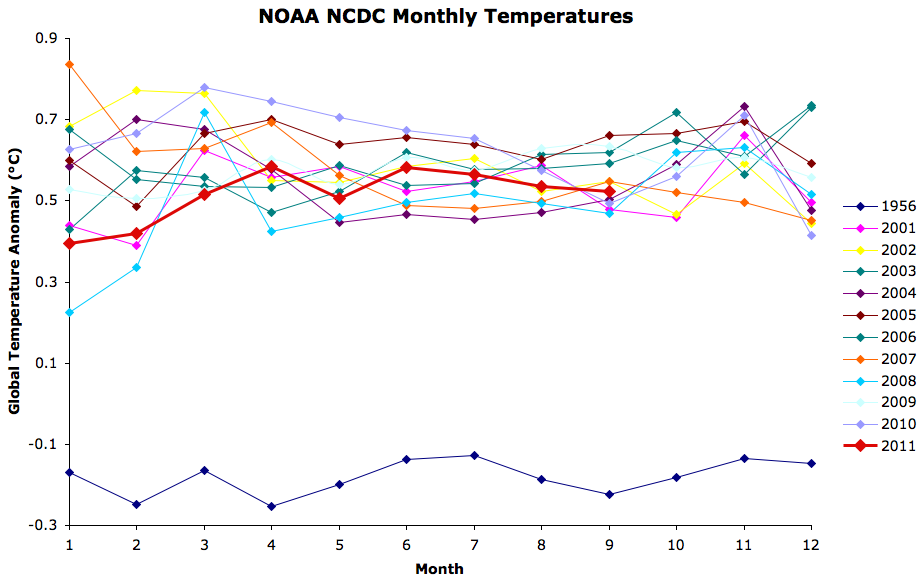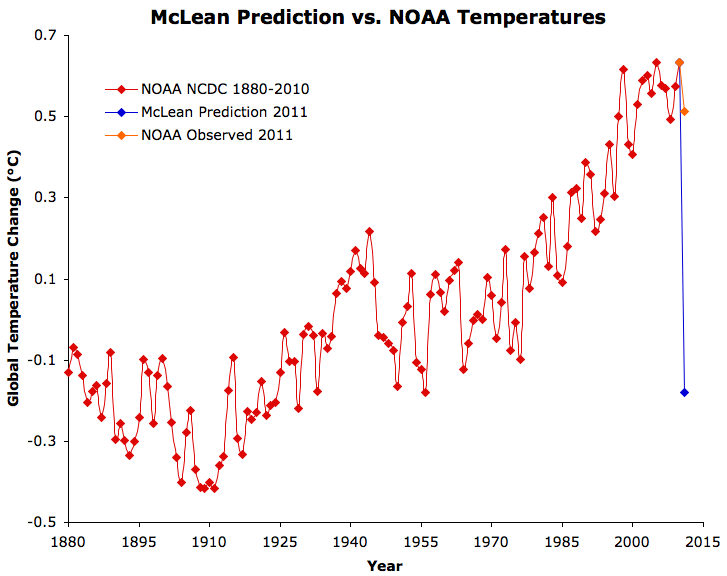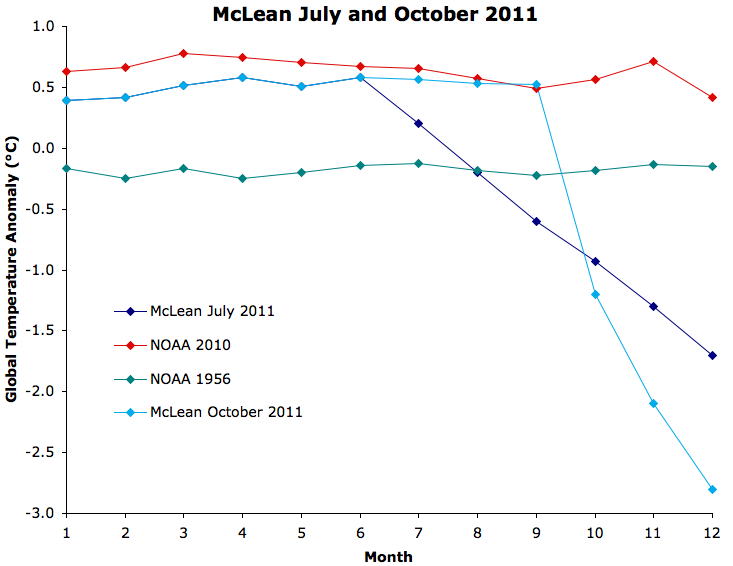9 Months After McLean
Posted on 25 October 2011 by dana1981
 In our previous post, The Day After McLean, we examined the 2011 global surface temperature prediction made by data analyst and climate "skeptic" John McLean. McLean's prediction was rather extreme, calling for the 2011 temperature anomaly to return to (or below) 1956 levels:
In our previous post, The Day After McLean, we examined the 2011 global surface temperature prediction made by data analyst and climate "skeptic" John McLean. McLean's prediction was rather extreme, calling for the 2011 temperature anomaly to return to (or below) 1956 levels:
"it is likely that 2011 will be the coolest year since 1956 or even earlier"
To be blunt, this was an unwise and uninformed prediction. For example, Figure 1 shows the monthly global surface temperature anomalies (from NOAA NCDC, whose accuracy the BEST project has confirmed) for the past decade (2001-2011) and for 1956.
Figure 1: NOAA NCDC monthly temperature anomalies
Every single month over the past decade has been at least 0.35°C warmer than the hottest month in 1956. And not surprisingly, every month in 2011 has been much warmer than the hottest month in 1956 as well, by 0.52 to 0.71°C through September. The annual data tells a similar story (Figure 2).
Figure 2: McLean 2011 prediction vs. NOAA annual global surface temperature anomalies, including 2011 anomaly through September.
As we discussed in The Day After McLean, average surface temperatures simply don't change from one year to the next by anywhere near the magnitude McLean predicted. The largest year-to-year temperature change from 1880 to 2010 according to NOAA data was 0.26°C (1963 to 1964). The average annual change was 0.078°C. McLean has predicted a 0.81°C cooling from 2010 to 2011 - more than 10 times the average change, and more than 3 times the largest year-to-year change on record.
Standing Behind Wrongness
Halfway through 2011 the NOAA global surface temperature anomaly was 0.50°C, on track to be 0.63°C hotter than McLean had predicted. I encountered McLean commenting on an article on the Australian website The Conversation, which publishes articles written by academics and researchers. I confronted McLean with his prediction and the fact that the planet was not on its way to freezing over, to see if he would admit his error. On the contrary, McLean stood behind his initial prediction:
"Last time I looked 2011 wasn't over yet. It's a bit premature of you to be crowing about an annual average when the year isn't complete."
Seeing an opportunity to cash in on his false bravado, I offered him a wager. If McLean’s prediction were wrong by less than half a degree Celsius at the end of 2011, he would win. If it winds up being incorrect by a least half a degree Celsius, I would win. Given that the average global surface temperature has not changed by more than 0.26°C from one year to the next, I thought that giving him a 0.5°C margin of error was a generous offer, but alas, McLean did not respond to my offer.
Figure 3 shows an example of how temperatures in the second half of 2011 would have had to change in order for McLean's prediction to be accurate at that point, and how they will have to change over the last 3 months.
Figure 3: Example of how the average global surface temperature would have had to change in the second half and third quarter of the year for McLean's 2011 temperature prediction to become accurate.
Such a radical temperature change would literally send us towards a new ice age, and yet McLean refused to admit in July 2011 that his prediction was wrong.
Basis for McLean's Wrong Prediction
So what possessed McLean to make such a radical prediction to begin with? The basis of the prediction was a paper we have previously examined, McLean et. al (2009). In their paper, McLean et al. found that the El Niño Southern Oscillation (ENSO) has a large influence on global temperature variability (i.e. short-term changes), but they also slipped a conclusion into their paper which was not supported by their research:
"Overall the results suggest that the Southern Oscillation exercises a consistently dominant influence on mean global temperature"
This claim is simply incorrect, and could not be supported by their research, because the first step in the McLean et al. analysis removed any long-term trends from the original temperature data. Thus their analysis was incapable of determining the dominant influences on long-term temperature changes. Although Foster et. al (2010) made this point, McLean apparently continues to believe that ENSO is the dominant driver behind global temperature changes. However, ENSO is an oceanic cycle which merely moves heat around between oceans and the surface, and thus cannot cause a long-term warming trend.
The failure of McLean’s prediction proves that the conclusion of his paper was wrong. 2011 has indeed been slightly cooler than 2010 because the former was influenced by a La Niña cycle, while the latter was influenced by an El Niño. However the difference between 2010 and 2011 has only been 0.12°C thus far, nowhere near McLean's predicted 0.81°C, because man-made global warming hasn’t disappeared, and ENSO (and other ocean cycles) aren’t really the dominant effect on global temperatures. They certainly have large short-term effects on temperatures on the order of a couple of tenths of a degree, but nowhere near as large as McLean seems to believe.
We contacted McLean for a comment on this post, and his only response was to say
"I'll be posting a comment on my web pages after the December data is available."
It will be interesting to see how he defends this ill-conceived prediction.































 Arguments
Arguments

































[DB] "The longest in the wirld measured by thermometers"
Which is nice, for Central England. But not of any substantive use when working out global trends.
Apples-n-oranges.
But then again, the CET pretty much agrees with BEST:
[Source]
(Note to self: Don't ever link directly to images in the Archive)
[DB] "This would have brought the closing temperature to more than 11 degrees C, a level which had never previously been reached. Needless to say, it did not happen (the trend across the decade was actually negative)."
Visual inspection of the temperature graphics posted above shows you wrong on this, even for just the CET. You compund your error by conflating that into the global arena.
"My comments on the G and T thread, Daniel Bailey, 34, (the second law) were also serious - an attempt to demonstrate that most of what is written about AGW is non-physical."
As for the G&T/2nd Law threads, you were shown to be wrong there as well, repeatedly. Which you again compound by repeating your unfounded errors.
"The only plausible explanation of AGW is the “higher is colder” theory, but that and the relevant data is another story."
Well, it's nice to see that you're at least consistent - albeit consistently wrong. If you wish again to take up your quest, and have something new to bring to the discussion, to tilt at the windmills of the 2nd Law/G&T, take it to the appropriate thread, not here.
[DB] "No, Skywatcher, and you won't find the CET thread either. Tamino is ruthless with errors."
Actually, I linked to the CET thread earlier in my response to you. That post, and many more, are available from The Archives.
And Tamino is only ruthless with those who so lack a grip on the science that they cannot even understand that they are wrong. "Not even wrong" wrong.
"The trend from 2000 to 2009 is marginally (not significantly) negative."
And what of it? That is like noting that "the air is cool today". You yourself note that there is no significance to it. You are simply and tediously wasting everyone's time here. Desist.
[DB] "As far as the CET/Tamino projections the thread has vanished (sadly missed) but I kept a note of the comments"
I, too keep track of things. Such as the location of the supposedly-missing Central England Temperature thread. Here are your comments on the CET thread you maintain has vanished:
May 3, 2008
May 8, 2008
May 12, 2008
May 13, 2008
July 7, 2008
July 8, 2008
August 7, 2008
August 22, 2008
September 7, 2008
September 9, 2008
October 3, 2008
November 12, 2008
The astute reader will note both the responses to you and the posting behavior you employ.
So, global temperatures than showed no significant sign of AGW, and temperatures were somewhat below the previous peak in the forties, which were well above the Little Ice Age minimum. Over the next 19 years, in the satellite era, CO2 increased steadily to 363ppm, or by 18%. What happened to the troposphere temperatures? Nothing happened to the troposphere temperatures. The average anomaly over the period was -0.12 degrees, and the averages for the first and last five years periods were -0.10 and -0.092 respectively. The least squares trend line was 0.038 degrees C per decade, and the probability of this having been registered by chance was 49%. That takes us to 1997 without observing AGW. What happened next? The famous 1998 peak increased the annual average by half a degree, to 0.43 degrees C. The fall in 1999 reversed this increase, to – 0.05 in 1999 and -0.06 in 2000. No one, so far as I know, attributes these changes to CO2, so we arrive at year 2001 without the CO2 increases in the 20th century having made any discernible difference to troposphere temperatures. CO2 at the end of the century had reached 370ppm. Then something really strange happened. The average global temperature moved up suddenly by about 0.2 degrees, which is substantial by climate science standards. Apart from the year 2008 (when it fell back to -0.04, you see why McClean had a chance) it has stayed up from 2002 to date. That step change is entirely responsible for the positive trend in the data from 1997 to date, which is 0.139 degrees per decade, and highly significant (the calculated 5% confidence limits are 0.85 to 1.92 degrees C per decade). Are the temperatures still rising? No. Although the period this century is short you can get an idea by asking how far back we must go to see a significant trend. The answer is 17 years, to 1994. The years from 2001 are nowhere near significance. So, to sum up, the UAH evidence for any global warming trend rests on the step increase from 2000 (-0.06degrees C) through 2001 (0.11 degrees C) to 2002 (0.22 degrees C). Are we really certain that that change had anything to do with rising CO2 levels? Would you like to try to persuade the Chinese to give up their industrial revolution on that evidence? Will the American shut off their air conditioning?[DB] "Before that, the available data, will all its uncertainties, shows a steady rise from the little ice age, peaking in the forties, and a slow fall thereafter to 1979, the start of the satellite era."
Incorrect. For convenience, I have demarcated the point at which all the wheels fell off your logic-wagon by striking out the subsequent logical fallacy avalanche.
Please use the Search function (really, as a participant in this forum since 2010, you should have learned to use this valuable resource long ago) to find out more about the multiple errors in your statement I've quoted above, not to mention those in the fallacy cascade that follows.
[DB] Fixed html hash tag.